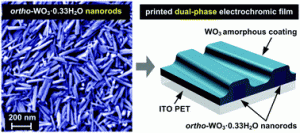 Nanostructured tungsten oxides (WOX) are an important class of materials owing to their electrochromic, photochromic, photochemical and sensing properties. In this study the morphology evolution of WOX nanoparticles was successfully controlled by altering the acidity level and the reaction time of the hydrothermal synthesis. Varying reaction conditions in this manner allowed the nanoparticles to be controlled to suit the desired printability and electrochromic performance.
Nanostructured tungsten oxides (WOX) are an important class of materials owing to their electrochromic, photochromic, photochemical and sensing properties. In this study the morphology evolution of WOX nanoparticles was successfully controlled by altering the acidity level and the reaction time of the hydrothermal synthesis. Varying reaction conditions in this manner allowed the nanoparticles to be controlled to suit the desired printability and electrochromic performance.
The “dual-phase” films deposited via inkjet printing technology exhibited values of transmission modulation over the visible and near infrared regions, as compared to the poor electrochromic performance of amorphous films. Films containing synthesized nanoparticles exhibited 2.5 times higher optical modulation and 2 times faster coloration time when compared with pure amorphous films.
As with other areas of nanoscience, the authors stress the importance of tailoring size and morphology of inorganic particles for a desired specification.
Tailoring nanoscale properties of tungsten oxide for inkjet printed electrochromic devices
Pawel Jerzy Wojcik, Lidia Santos, Luis Pereira, Rodrigo Martins and Elvira Fortunato
Nanoscale, 2015, Advance Article. DOI: 10.1039/C4NR05765A
Dr Mike Barrow is a guest web writer for the Nanoscale blog. He currently works as a Postdoctoral Researcher at the University of Liverpool.










